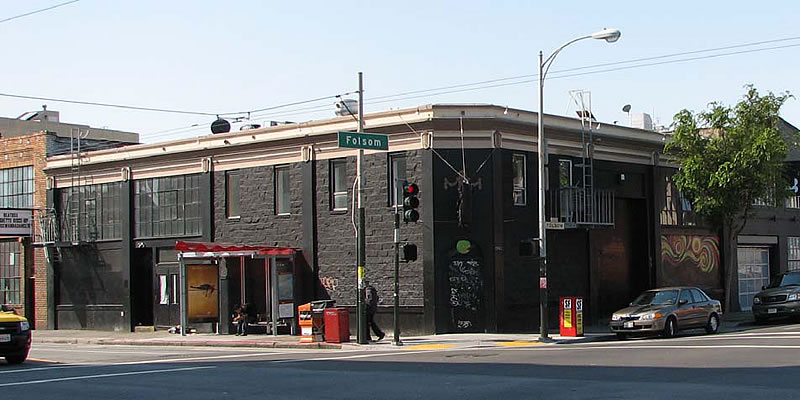The liquor license is pending. And if the ambitious plans are approved next month, a new partial third floor and 1,200-square-foot outdoor deck will be added atop the old Paradise Lounge at the corner of Folsom and 11th and the club along Western SoMa’s 11th Street Corridor will re-open as “Calle-Once,” with a rooftop restaurant and perhaps a bit of Latin flair.
The onetime home to FeBe’s, the first leather bar to open on Folsom Street, from 1966 to 1986, a bid to turn the 1501 Folsom Street space into a 125-seat cabaret theater and Trannyshack revival was rejected by the landlord last year.

Thumbs up to any establishment that includes outdoor space. More of that, please.
And it should be good fun to hear all the different wrong pronunciations of “Calle Once”.
Can’t wait to get my Marg’ on at Kal Wuns!
I tried kale once, it was terrible.
Glad to hear some progress on this. That building has sat vacant for far too long. Hopefully the shuttered bar across the street can find a new live, too.
Heklina from Trannyshack is trying to open a club across Folsom Street. Some permitting changes were required to be approved by the city.
It’s a shame that the place across Folsom street has been closed down for years. Like over a decade? It is exhibit one in the war on Nightlife. It’s so far back in per-history that I don’t even remember the complaints on the then business, but that’s no reason to keep the physical location shut off for nightlife purposes forever.
Here’s a story on the old Oasis space: Political Notebook: Zoning causes hiccup for planned SOMA gay club.
In LA the last Silver Lake gay bar closed. WEHO is now known for ticketing/towing/rapper shoot-em-ups.
Meanwhile we can’t just go on and admit that SOMA is — again, if you’re a student of history — an SF suburb, with all the rights and privileges.
Suburb, my ass. A suburb of what, the Financial District?
SOMA was residential before the current uses, go back and look at your Sanborn maps. There is still TONS of residential in SOMA, do you have eye “ess”? Take a walk around particularly in the alleys. In point of fact the Western SOMA plan has zoned many as Residential Enclaves (RED) Districts. Beyond the REDs there is housing along every major corridor. More residential than “PDR” districts. I have nothing against clubs provided they abide by the promises they made before the Entertainment Commission in order to get their permits. In fact few if any keep their promises. Look no further than Sloane, now closed with a bunch of lawsuits. Wrongful Death the lethal blow (excuse that one). They never listened to the neighborhood that they illegally expanded into. Never, not once!
I have lived in the city all my life and in SOMA the last 15 years. Ess it’s pointless to reason with facts, you already have made up your mind.
As a resident nearby this terrifies me. My building was residential before ANY of the clubs were there. The noise is already bad enough from Beatbox and Audio Nightclub. And now they want to put in a club with an accompanying outdoor space? As in, ZERO soundproofing? I literally will not be able to sleep ever. This will have a serious detriment on the mental health of nearby residents.
You bet your a** I’ll be at the hearing.
“Old San Francisco, which is the San Francisco of only the other day, the day before the Earthquake, was divided midway by the Slot. The Slot was an iron crack that ran along the center of Market street, and from the Slot arose the burr of the ceaseless, endless cable that was hitched at will to the cars it dragged up and down. In truth, there were two slots, but in the quick grammar of the West time was saved by calling them, and much more that they stood for, “The Slot.” North of the Slot were the theaters, hotels, and shopping district, the banks and the staid, respectable business houses. South of the Slot were the factories, slums, laundries, machine-shops, boiler works, and the abodes of the working class.”
South of the Slot, Jack London, 1909
Historically, SOMA is the industrial and working class heart of SF.
“During the Gold Rush era, South of Market served as the most productive industrial zone on the West Coast. In the years following the gold rush, the area evolved into a mixed-use neighborhood. This is in part attributed to the fact that residential uses were developed in conjunction with industrial facilities, to provide convenient access for industrial workers who could not yet afford public transit.”
San Francisco General Plan, SF Planning Dept
Um….Akbar, Eagle, Faultline?
maybe a very poor student of history who missed most of the classes and failed the final.
Yes, and we should all just admit that South beach is – again, you’re a student of history – underwater.
The old Phebe’s , a gay biker bar.
UPDATE: Iconic Western SoMa Club Building on the Market for $6 Million